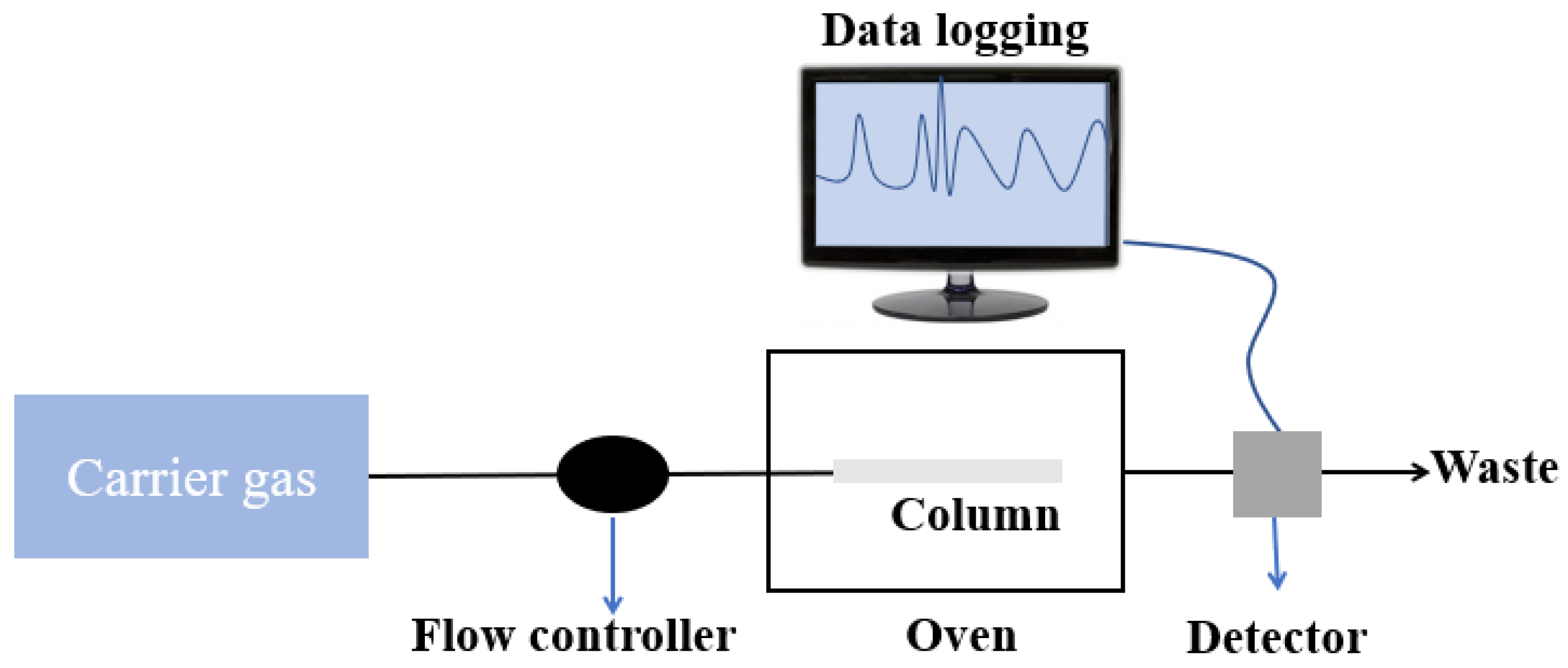In general, volatile organic compounds (VOCs) have a high vapor pressure at room temperature (RT). It has been reported that all humans generate unique VOC profiles in their exhaled breath which can be utilized as biomarkers to diagnose disease conditions. The aforementioned discussions show that the human breath contains a variety of VOCs that serve as biomarkers for various diseases and metabolic problems. Therefore, the real-time monitoring of such VOCs in the exhaled human breath is highly essential to enable non-invasive illness detection. In the following subsections, aA detailed discussion has been carried out to understand various techniques developed to detect VOCs in very low concentrations of part per million volumes (ppmv), part per billion volumes (ppbv), and part per trillion volumes (pptv).
- breath analysis
- sensor
- volatile organic compound
- biomarker
- molecularly imprinted polymer
1. Gas Chromatography–Mass Spectrometry (GC–MS) Techniques

2. Selected-Ion Flow-Tube Mass Spectrometry (SIFT-MS)

3. Proton-Transfer-Reaction Mass Spectrometry (PTR-MS)

4. Advantages and Limitations of Classical VOC Detection Techniques
| Technique | Advantage | Limitations |
|---|---|---|
| GC–MS |
|
|
| PTR-MS |
|
|
| SIFT-MS |
|
|
References
- Sanchez, J.M.; Sacks, R.D. GC Analysis of Human Breath with A Series-Coupled Column Ensemble and a Multibed Sorption Trap. Anal. Chem. 2003, 75, 2231–2236.
- Lord, H.; Yu, Y.; Segal, A.; Pawliszyn, J. Breath Analysis and Monitoring by Membrane Extraction with Sorbent Interface. Anal. Chem. 2002, 74, 5650–5657.
- Giardina, M.; Olesik, S.V. Application of Low-Temperature Glassy Carbon-Coated Macrofibers for Solid-Phase Microextraction Analysis of Simulated Breath Volatiles. Anal. Chem. 2003, 75, 1604–1614.
- Schnabel, R.; Fijten, R.; Smolinska, A.; Dallinga, J.; Boumans, M.-L.; Stobberingh, E.; Boots, A.; Roekaerts, P.; Bergmans, D.; van Schooten, F.J. Analysis of volatile organic compounds in exhaled breath to diagnose ventilator-associated pneumonia. Sci. Rep. 2015, 5, 17179.
- Durán-Acevedo, C.M.; Jaimes-Mogollón, A.L.; Gualdrón-Guerrero, O.E.; Welearegay, T.G.; Martinez-Marín, J.D.; Caceres-Tarazona, J.M.; Sánchez-Acevedo, Z.C.; de Jesus Beleño-Saenz, K.; Cindemir, U.; Österlund, L.; et al. Exhaled breath analysis for gastric cancer diagnosis in Colombian patients. Oncotarget 2018, 9, 28805–28817.
- Adams, N.G.; Smith, D. The selected ion flow tube (SIFT); A technique for studying ion-neutral reactions. Int. J. Mass Spectrom. Ion Phys. 1976, 21, 349–359.
- Smith, D.; Spanel, P. The Novel Selected-ion Flow Tube Approach to Trace Gas Analysis of Air and Breath. Rapid Commun. Mass Spectrom. 1996, 10, 1183–1198.
- Španěl, P.; Davies, S.; Smith, D. Quantification of breath isoprene using the selected ion flow tube mass spectrometric analytical method. Rapid Commun. Mass Spectrom. 1999, 13, 1733–1738.
- Diskin, A.M.; Španěl, P.; Smith, D. Time variation of ammonia, acetone, isoprene and ethanol in breath: A quantitative SIFT-MS study over 30 days. Physiol. Meas. 2003, 24, 107–119.
- Abbott, S.M.; Elder, J.B.; Španěl, P.; Smith, D. Quantification of acetonitrile in exhaled breath and urinary headspace using selected ion flow tube mass spectrometry. Int. J. Mass Spectrom. 2003, 228, 655–665.
- Walton, C.; Patel, M.; Pitts, D.; Knight, P.; Hoashi, S.; Evans, M.; Turner, C. The use of a portable breath analysis device in monitoring type 1 diabetes patients in a hypoglycaemic clamp: Validation with SIFT-MS data. J. Breath Res. 2014, 8, 037108.
- Alkhouri, N.; Cikach, F.; Eng, K.; Moses, J.; Patel, N.; Yan, C.; Hanouneh, I.; Grove, D.; Lopez, R.; Dweik, R. Analysis of breath volatile organic compounds as a noninvasive tool to diagnose nonalcoholic fatty liver disease in children. Eur. J. Gastroenterol. Hepatol. 2014, 26, 82–87.
- Samara, M.A.; Tang, W.H.W.; Cikach, F.; Gul, Z.; Tranchito, L.; Paschke, K.M.; Viterna, J.; Wu, Y.; Laskowski, D.; Dweik, R.A. Single Exhaled Breath Metabolomic Analysis Identifies Unique Breathprint in Patients with Acute Decompensated Heart Failure. J. Am. Coll. Cardiol. 2013, 61, 1463–1464.
- Hansel, A.; Jordan, A.; Holzinger, R.; Prazeller, P.; Vogel, W.; Lindinger, W. Proton transfer reaction mass spectrometry: On-line trace gas analysis at the ppb level. Int. J. Mass Spectrom. Ion Process. 1995, 149–150, 609–619.
- Amann, A.; Poupart, G.; Telser, S.; Ledochowski, M.; Schmid, A.; Mechtcheriakov, S. Applications of breath gas analysis in medicine. Int. J. Mass Spectrom. 2004, 239, 227–233.
- Karl, T.; Prazeller, P.; Mayr, D.; Jordan, A.; Rieder, J.; Fall, R.; Lindinger, W. Human breath isoprene and its relation to blood cholesterol levels: New measurements and modeling. J. Appl. Physiol. 2001, 91, 762–770.
- Schmutzhard, J.; Rieder, J.; Deibl, M.; Schwentner, I.M.; Schmid, S.; Lirk, P.; Abraham, I.; Gunkel, A.R. Pilot study: Volatile organic compounds as a diagnostic marker for head and neck tumors. Head Neck 2008, 30, 743–749.
